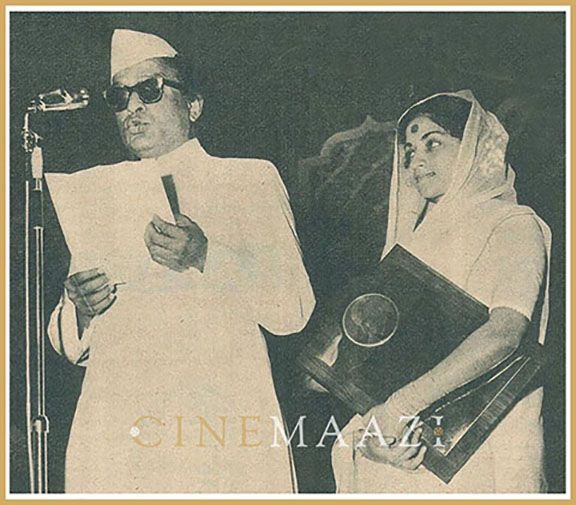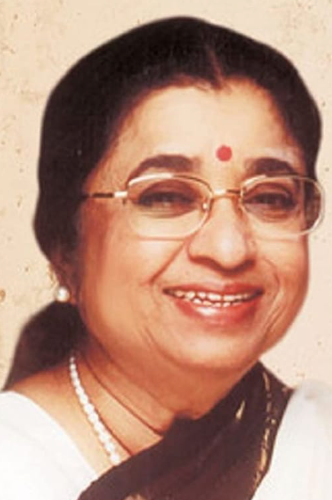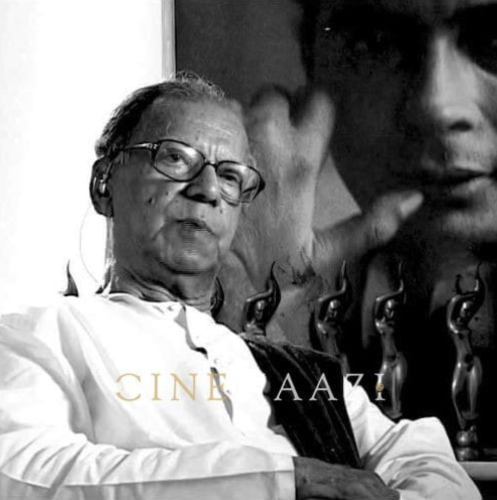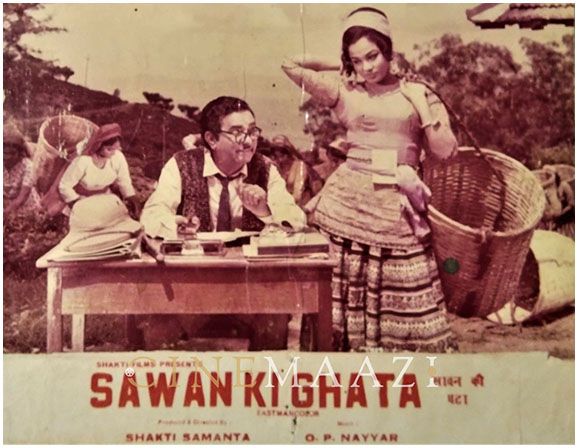
An image from the original article showing V Shantaram and Sandhya.
"'Do Ankhen brought me honours and also trouble with my eyes," says V Shantaram, who recently went to Hollywood to receive the Samuel Goldwyn International Film Award for his picture.
Shantaram explained that he had injured his eye in the encounter with the bull, while playing the hero's role in the film the injury left after-effects.
"I am thankful that my eye is all right now," he said.
"Many hands" applauded Producer-director-actor V. Shantaram when he stepped forward to receive the Samuel Goldwyn International Film Award won by his film "Do Ankhen Barah Haath," (1957) first Indian film to win a top award in Hollywood.
"Many hands" applauded Producer-director-actor V. Shantaram when he stepped forward to receive the Samuel Goldwyn International Film Award won by his film "Do Ankhen Barah Haath," (1957) first Indian film to win a top award in Hollywood.Shantaram, though wearing dark glasses, otherwise looked the picture of health. Sandhya was there too.
Shantaram said, "The Samuel Goldwyn International Film Award of the Hollywood Foreign Press Association made to my film is the biggest honour of my career.
"In Hollywood, the Foreign Press Association awards have great value because more than half the American film industry's earnings come from abroad and the presentations are naturally an event of note. The occasion is eagerly awaited."
Describing the function, Shantaram wished there was something similar in India.
"The Cocoanut Grove at Hollywood's famous Ambassador Hotel was packed with film celebrities as well as men and women who count in the world of literature, arts and science," he said.

"Sandhya and I were at the main table, sitting with Maurice Chevalier, Gary Cooper, Samuel Goldwyn, David Niven and the President of the Hollywood Foreign Press Association."
"After dinner, the President introduced Mr. Samuel Goldwyn to the audience. He recounted Mr. Goldwyn's services to films.
"Followed a flourish from the orchestra and an announcer mounted the platform. In this envelope is the name of the winner of the Samuel Goldwyn International Film Award for 1958," he said.
"There was another crash of music as he opened the envelope and handed the paper to Mr. Goldwyn who addressed the gathering, saying, "The Hollywood Foreign Press Association has established the Samuel Goldwyn International Film Award to be presented each year to the picture selected by the Association as the best foreign film of the year. It gives me great pleasure to announce, as...."
"Mr. Goldwyn halted to let the orchestra create a note of suspense." (The Awards are a closely guarded secret and, till they are presented, only the winners and senior members of the Association know who has won them. The greatest expectancy precedes the presentation of each award.)
"Mr. Goldwyn concluded his announcement.... 'the winner of the Award for 1958, the motion picture entitled 'Two Eyes, Twelve Hands,' the film made in India, and to present this award to its producer, director and star, V. Shantaram."
"The hall resounded with thunderous applause mingled with the loud strains of the orchestra as Sandhya and I went up to the dais to receive the Award."
"My speech, particularly when I said that the most important feature of my winning the Award with 'Do Ankhen Barah Haath' was that it was recognition of the theme of the film, the victory of moral force and non-violence over evil, was interrupted by applause."
"There was also an ovation when I presented Sandhya as a representative of India's womanhood."

"Sandhya was a hit in Hollywood, for she is typically Indian. Mark Robeson, director of the Best Picture promoting international understanding, "The Inn of the Sixth Happiness," said 'Here we admire the Indian girls who represent their motherland in culture, dress and conduct and do not try to copy our girls. Americanised Indian girls seldom attract us, for we have our own American beauties.'"
Here Sandhya broke in to say that many people were curious to see her dressed all in white and wearing no jewels.
Her simple attire (with her white sari Sandhya wore no ornaments, only bangles of glass) charmed them.
She continued, "Pointing to my glass bangles, Gary Cooper said, 'Nice bracelets. How do you sleep, wearing them on your wrists all night? Don't they break?'
"Then there was the vivacious Loretta Young, as youthful-looking as she is seen in films. She was surprised that I wore no make-up."
"How can women live without make-up?," she said. 'Do most Indian women go about without any make-up?'
"I assured her that most Indian women do not even know the names of the different make-up materials."
Sandhya was popular with her American friends. She greeted one and all with the traditional Namaste. Many Americans learnt from her the Indian form of salutation. Her aptest pupil was Mr. Samuel Goldwyn.
Sandhya was popular with her American friends. She greeted one and all with the traditional Namaste. Many Americans learnt from her the Indian form of salutation. Her aptest pupil was Mr. Samuel Goldwyn.Returning to the subject of the function, Shantaram said, "Important film personalities distribute these Awards by turn. In the process, many pioneers are honoured. Moreover, every winner is expected to 'perform' either with a speech or a song, after he has received the prize.
"This year, for example, there was the song sung by the 'seventy years young' Maurice Chevalier when he received the Cecil B. DeMille Award for outstanding contribution and achievement. It held the audience spell-bound."
Shantaram himself was congratulated after the function for the thought-providing things he said in his speech.
Though he has visited the United States before, this was Shantaram's first visit to the film capital and he made good use of it to see the major film studios, meet film people and see film-making in Hollywood.
One of the studios he visited was Twentieth Century-Fox. The gigantic indoor and outdoor sets impressed him.
He was also interested to learn that the larger studios kept themselves busy with a steady programme of films. They preferred this to working on big-budget pictures which could only be few.
"They have to keep the studios running," he says, "and must produce as many films as are necessary to keep their men and women in their jobs."
"Conditions in India and in America are similar. There, too, some of the stars are temperamental, and work is sometimes as erratic as it is in Indian film studios.
"Equipment and methods are also the same, but I am proud to say that my Rajkamal Studio has equipment which can match the best hat Hollywood has.
"One difference is the way easy way stars are discovered there. The glamour of American life makes it so. Moreover, there is the advantage of having the stage, which has reached a degree of development we don't yet have and is well pastronised."
At the press conference, held the following day, Shantaram answered pressmen.
Demanded a hard-boiled film critic: "You believe in imparting some sort of message through your films. People in American films say, 'Let Western Union (the Telegraphs) deliver messages, we produce pictures.' We want entertainment for the sake of entertainment. Do you agree with us?"
Shantaram: "I beg to differ, Sir. Even in your great country, a film with many as ten messages proved an all-time box office hit."
Several voices affirming in chorus: "Yes, yes. 'The Ten Commandments'".
Another voice: "We want a lot of sex in films."
Shantaram: "That you have in every film. Whenever there is a man and woman in the film, there is sex."
A voice: "That is not enough. Some people here want nudity of some sort."
Shantaram: "Don't you think that nudity is boring? A woman looks different and is attractive each time she puts on new raiment."
Question from a serious-minded critic: "What is the use of moral force in this world torn by fear and hatred?"
Shantaram: "For such a world, faced with such a catastrophe, moral force is the only salvation. Without moral force, mutual understanding and love will not develop and the world will destroy itself. Film-makers have a duty, in this trouble-torn world, to create goodwill through the films they make."
Another questioner: Suppose you get a chance to produce and direct a film in our country, how would you in that case present the American way of life?"
Shantaram: "I believe there is a lot of good in every man in every country, and I would present in my film all that is good in American film-makers do the same when presenting the Indian way of life in their films."
The last question: "Who has influenced you most in your art?"
"In the matter of art, a man does not learn from only one teacher. He learns from the work of as many masters as he becomes acquainted with in his career. In fact, the true artist remains a student all his life." "However, if you ask me to tell you the name of the first master who influenced me, I would unhesitatingly say it was D.W. Griffith."
Shantaram: "In the matter of art, a man does not learn from only one teacher. He learns from the work of as many masters as he becomes acquainted with in his career. In fact, the true artist remains a student all his life.""However, if you ask me to tell you the name of the first master who influenced me, I would unhesitatingly say it was D.W. Griffith."
During his stay in Los Angeles, Shantaram did not have much time for sight-seeing, but the one thing which impressed him most was the huge and beautiful painting of the Crucifixion of Christ. Thousands of people go to see it.
The painting, 190 feet long and 40 feet high, is housed all by itself in a building constructed for its display. A nominal entrance-fee is charged for the building's upkeep and the salaries of the attendants.
The painting left a lasting impression on the minds of both Shantaram and Sandhya. Sandhya felt that one could have a similar memorial depicting a significant event in the life of Gandhiji, as a national memorial to the Father of the Nation.
Shantaram had to cut short his foreign tour to return for work on his colour film, "Navrang" (1959). He came back to India via Japan.
Of present-day Japan, Shantaram say, "The country has undergone a sudden and complete metamorphosis since the war. Her oriental character is fading away."
This article was published in Filmfare magazine’s 22 May, 1959 edition as a part of 'Filmfare Reviews' of the film "Do Ankhen Barah Haath" (1957).
Tags
About the Author
Other Articles by Cinemaazi
17 Feb,2024
What is a Good Documentary Film?
25 Jan,2024
Salute to an Immortal Spirit
22 Jan,2024
A Painful Parting
29 Nov,2023
Children's Film Society
28 Oct,2023
Let's Give the Kids a Chance
26 Oct,2023
Directing the Child Actor
25 Oct,2023
Chandu - The Elephant Boy
23 Oct,2023
HEROISM-Children's Film Society gives the lead
18 Oct,2023
Munna
29 Sep,2023
ख्वाजा अहमद अब्बास का पत्र महात्मा गांधी के नाम
02 Sep,2023
Shakti Kapoor: It's Three Punches A Day
04 Jul,2023
Should a Filmmaker be Original?
24 Jun,2023
Babita My First Screen Love
22 Jun,2023
Phir Wohi Dil Laya Hoon
19 Jun,2023
Romance in Our Cinema
12 Jun,2023
The Romance of our Show Houses
12 Jun,2023
Kashmir Ki Kali (1964)
07 Jun,2023
Sangam (1964)
05 Jun,2023
This thing called Love
25 May,2023
Gandhi: Whose voice?
15 May,2023
"Deewar" Becomes a Nation's Prayer
15 May,2023
Mangal Pandey
06 May,2023
History of Cinema, History of the Nation
02 May,2023
Birbal Paristan Mein
20 Apr,2023
Reincarnation... the story goes on ever after
27 Mar,2023
The Film Director?
21 Mar,2023
M Sadiq
15 Mar,2023
The Social Role of the Cinema
15 Mar,2023
"Samaj" A Memorable Film with Popular Appeal
20 Feb,2023
Do Dooni Chaar
15 Feb,2023
Rafoo Chakkar
07 Feb,2023
Johnny Walker.... still going strong
20 Jan,2023
Mahabharat : Epic Tamasha
10 Jan,2023
Narsi Bhagat : An Excellent Biography
03 Jan,2023
Nav Ratri
01 Dec,2022
एक ताजगी का नाम है देवानन्द (Dev Anand)
25 Nov,2022
जे बी एच वाडिया (J B H Wadia) - वचन न जाए
14 Nov,2022
Children's Films in India
01 Sep,2022
Horses .... Cars and Laughs-Mehmood
06 Aug,2022
हिन्दी फिल्मों की दुर्दशा का जिम्मेदार कौन?
01 Aug,2022
क्या हिंदी फिल्मों से हास्य गायब हो रहा है?
20 Jul,2022
हास्य की परंपरा और हास्य अभिनेताओं की भूमिका
12 Jul,2022
प्राण और उनकी दाढ़ियाँ
17 Feb,2022
Odds Against a New Comer
10 Dec,2021
Speaking of Portraits and People
03 Nov,2021
An Actor Prepares
19 Oct,2021
Producers' War on Dubbed Films
24 Aug,2021
Jottings from a Film Director's Notebook
26 Jul,2021
प्रेमचंद सत्यजीत राय और ’सद्गति’ -गिरिजाशंकर
22 Jul,2021
Rewind 1990 Commerce of Love Stories
20 Jul,2021
Eastern Scene: Cinema of Surviving Faith
22 Jun,2021
Movie Memories : Tansen (1943)
22 Jun,2021
Movie Memories: Sikandar (1941)
15 Jun,2021
Towards A Brighter Future- Bengali Cinema
20 May,2021
The Enigma Of A Flux - Malayalam Cinema
05 May,2021
The seesaw graph of Hindi filmdom
03 May,2021
Ankahee: The Unspoken
29 Apr,2021
The Mahatma Returns: World Press Reaction
29 Apr,2021
Children’s Films
17 Apr,2021
Telugu Cinema in 1986- Sons and Fathers
09 Apr,2021
Mukhamukham : Face to Face
08 Apr,2021
Tarang : Wages and Profits
01 Apr,2021
Design In Indian Cinema
27 Mar,2021
Movie Memories : Savkari Pash
23 Mar,2021
Double Trouble: Role of Twins In Hindi Cinema
22 Mar,2021
Prem Chopra: The Same Role For Ever
19 Mar,2021
Kalyan Kumar - Karnataka’s Self-Made Star
18 Mar,2021
Ceylon's Cyclonic Cinema
18 Mar,2021
Movie Memories : Aladdin & the Wonderful Lamp
17 Mar,2021
Kumari Padmini: Rising New Star Of The South
11 Mar,2021
50 YEARS OF MALAYALAM CINEMA
02 Mar,2021
Alakh Niranjan: Film India Review
27 Feb,2021
Party: The Story of Choices
26 Feb,2021
The Naushad Era In Hindi Film Music
19 Feb,2021
A Man: Amitabh Bachchan -Amitabh, is My Name
10 Feb,2021
A Man: Amitabh Bachchan - Two of a Kind
29 Jan,2021
Women In Hindi Films : Dichotomy of Values
22 Jan,2021
A Man: Amitabh Bachchan - Yesterday and Tomorrow
22 Jan,2021
Cinema in the South: Crisis of Character
18 Jan,2021
Film Societies Play Their Part
01 Jan,2021
Nutan : A Flashback - The Actress
30 Dec,2020
"Gwalan" Proves A Thrilling Entertainment !
29 Dec,2020
Rajesh Khanna : Echoes Of An Era- Family Of Four
28 Dec,2020
Holi: A Metaphor for Horizontal Violence
23 Dec,2020
A Summon for Mohan Joshi
22 Dec,2020
Nutan : A Flashback - The Friend
22 Dec,2020
Raj Kapoor Scores Personal Triumph In “Aag”!
19 Dec,2020
Smita Patil's Memoir- Trading Places
17 Dec,2020
Shashi Kapoor: Once Upon A Time- The Film Makers
16 Dec,2020
Rajesh Khanna : Echoes Of An Era- Peer Pressures
15 Dec,2020
“Lal Haveli”- Crude But Entertaining!
12 Dec,2020
Nutan : A Flashback - The Wife
10 Dec,2020
Rajesh Khanna : Echoes Of An Era
09 Dec,2020
"Lalkar" Presents Cheap Entertainment
07 Dec,2020
Smita Patil's Memoir-Comrades In Arms
01 Dec,2020
Shashi Kapoor: Once Upon A Time- Unjinxed
28 Nov,2020
Ek Din Ka Sultan- Becomes Good Entertainer !
26 Nov,2020
Smita Patil's Memoir- Friendly Strokes
25 Nov,2020
Shashi Kapoor: Once Upon A Time- Tough Times
07 Nov,2020
The Technician And His Problems
06 Nov,2020
We Must Inject Dynamism Into Publicity
05 Nov,2020
The Role Of Film Finance Corporation
04 Nov,2020
Progress In Raw Film
30 Oct,2020
Freedom In Films
28 Oct,2020
Export Market For Indian Films
23 Oct,2020
The Growth of The Motion Picture
22 Oct,2020
Setup Of The Film Industry
21 Oct,2020
Few Facts About Film Production
13 Oct,2020
Personalisation In Cinema
08 Oct,2020
Waiting for a Doyen's Glance- Arati Bhattacharya
08 Oct,2020
कौन सुनेगा इन सिसकती बिलखती प्रतिभाओं का विलाप?
06 Oct,2020
Asrani - Laugh And The World Laughs With You
05 Oct,2020
My Memorable Roles- Hiralal
03 Oct,2020
राजीव गोस्वामी - कहां थे अब तक 'पेंटर बाबू'?
03 Oct,2020
जब नफरत से बेड़ा पार हो गया: बलराज साहनी
30 Sep,2020
The Case of Emotional Turmoil In Dopatta (1952)
29 Sep,2020
The Story Of A Child Artiste - Sheela Kashimiri
26 Sep,2020
Afsana Likh Rahi Hoon : Tun Tun
26 Sep,2020
Some Hopes For The New Year: Lillian
24 Sep,2020
Joru Ka Bhai: A Tale of 'Atithi Tum Kab Jaoge'
22 Sep,2020
अभिनेता प्रेमअदीब से भेंट
21 Sep,2020
Vijaylaxmi: A Career As The 'Other' Woman
18 Sep,2020
Shaminder: The Actor Who Had High Hopes
16 Sep,2020
धर्मेन्द्र - समय आ रहा है...
14 Sep,2020
Film Life After Fifty : Motilal
14 Sep,2020
प्रसिद्ध फिल्म लेखक गुलशन नंदा से आपकी बातचीत
11 Sep,2020
"I live on hope"- Kumkum
11 Sep,2020
Thehr Zara O Jane Wale : Madhubala Jhaveri
09 Sep,2020
Ratnamala Attracts Attention In ‘Station Master’
08 Sep,2020
Ghory: The Laurel Of Indian Cinema's Comedy Duo
07 Sep,2020
Yeh Teri Saadgi, Yeh Tera Baankpan: Usha Khanna
07 Sep,2020
सेनापति शेट्टी
05 Sep,2020
कृतिदेव यहां मैं, तनूजा, स्वीकार करती हूँ
05 Sep,2020
मै उर्मिला को भूल नहीं पाती - मंजरी
04 Sep,2020
बुलबुल बंगाल की: चंद्राणी मुखर्जी
03 Sep,2020
Payyal's Lucky Break
02 Sep,2020
These Foreign Producers
29 Aug,2020
The Practical Actress: Shabnam
29 Aug,2020
“Amrit” Becomes A First Class Picture
28 Aug,2020
फिल्मी मारपीट के गुरू : अजीम भाई
26 Aug,2020
From Poverty to Screen Fame - Mehboob Khan
26 Aug,2020
Humility: Nasreen's Most Admirable Feature
24 Aug,2020
A Mercenary Comes To India - Bob Christo
23 Aug,2020
Dilip Kumar: The Leader
19 Aug,2020
Alam Ara: Ardeshir Irani's Ambitious Secret
17 Aug,2020
I Serve My Art- Kanan Devi
10 Jul,2020







.jpg)


